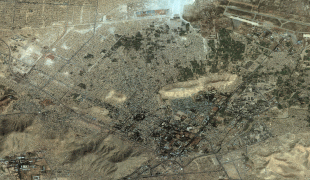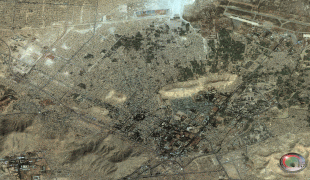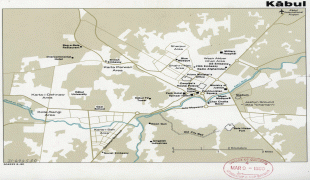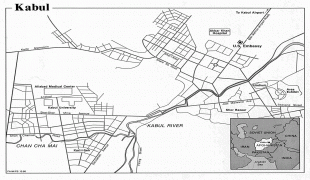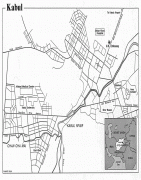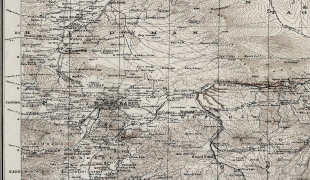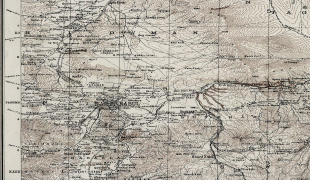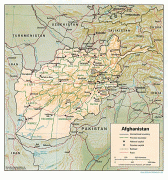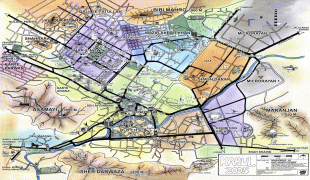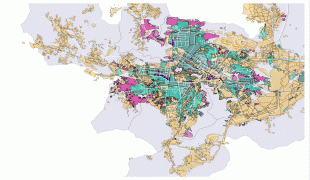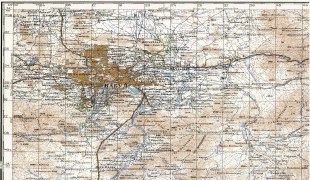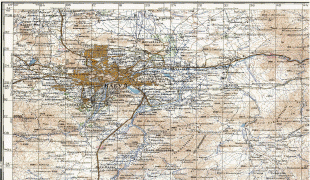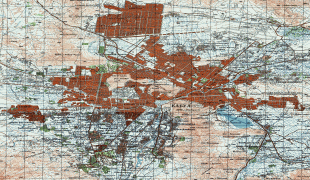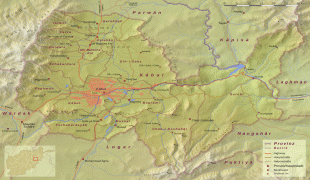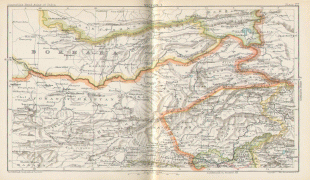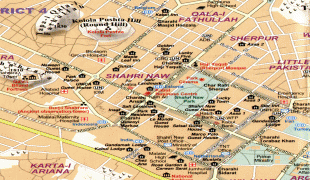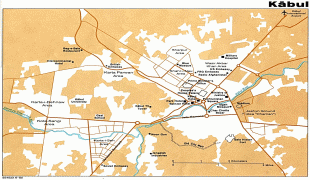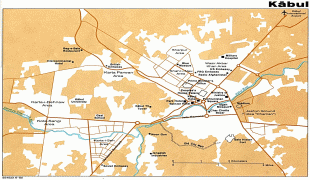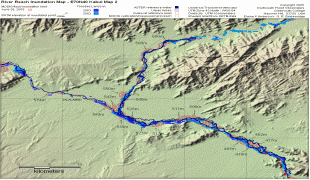Kabul
Kabul is the capital and largest city of Afghanistan. Located in the eastern half of the country, it is also a municipality, forming part of the Kabul Province; it is administratively divided into 22 municipal districts. According to late 2022 estimates, the population of Kabul was 3.5 million people. In contemporary times, the city has served as Afghanistan's political, cultural, and economical centre, and rapid urbanisation has made Kabul the 75th-largest city in the world and the country's primate city.
The modern-day city of Kabul is located high up in a narrow valley between the Hindu Kush, and is bounded by the Kabul River. At an elevation of 1790 m, it is one of the highest capital cities in the world. Kabul is said to be over 3,500 years old, mentioned since at least the time of the Achaemenid Persian Empire. Located at a crossroads in Asia—roughly halfway between Istanbul, Turkey, in the west and Hanoi, Vietnam, in the east—it is situated in a strategic location along the trade routes of Central Asia and South Asia, and was a key destination on the ancient Silk Road; It was traditionally seen as the meeting point between Tartary, India, and Persia. Kabul has also been under the rule of various other dynasties and empires, including the Seleucids, the Kushans, the Hindu Shahis, Western Turks, the Turk Shahis, the Samanids, the Khwarazmians, the Timurids, and the Mongols, among others. In the 16th century, the Mughal Empire used Kabul as a summer capital, during which time it prospered and increased in significance. It briefly came under the control of the Afsharids following Nader Shah's invasion of India, until finally becoming coming under local rule by the Afghan Empire in 1747; Kabul became the capital of Afghanistan in 1776, during the reign of Timur Shah Durrani (a son of Ahmad Shah Durrani). In the 19th century, the city was occupied by the British, but after establishing foreign relations and agreements, they were compelled to withdraw all forces from Afghanistan and returned to British India.
Kabul is known for its historical gardens, bazaars, and palaces; well-known examples are the Gardens of Babur and Darul Aman Palace, as well as the Arg. In the second half of the 20th century, it became a stop on the hippie trail undertaken by many Europeans, and the city also gained the nickname "Paris of Central Asia" during this time. However, this period of tranquility ended in 1978 with the Saur Revolution and subsequent Soviet military intervention in 1979, which sparked the protracted Soviet–Afghan War until 1989. The 1990s were marked by continuous civil wars between various splinter factions of the disbanded Afghan mujahideen, which destroyed much of the city. In 1996, Kabul was captured by the Taliban after four years of intermittent fighting with other Afghan factions. However, the Taliban-ruled city soon fell to the United States after the American-led invasion of Afghanistan in 2001. In 2021, Kabul was re-captured by the Taliban following the withdrawal of American-led military forces from Afghanistan.
Kabul (, ; کابل ', ; ', ) is also spelled as Cabool, Cabol, Kabol, or Cabul.
Kabul was known by different names throughout history. Its meaning is unknown, but "certainly pre-dates the advent of Islam when it was an important centre on the route between India and the Hellenic world". In Sanskrit, it was known as Kubha, whereas Greek authors of classical antiquity referred to it as Kophen, Kophes or Koa. The Chinese traveler Xuanzang (fl. 7th century CE) recorded the city as Kaofu(高附). The name "Kabul" was first applied to the Kabul river before being applied to the area situated between the Hindu Kush and Sindh (present-day Pakistan). This area was also known as Kabulistan. Alexander Cunningham (died 1893) noted in the 19th century that Kaofu as recorded by the Chinese was in all likelihood the name of "one of the five Yuchi or Tukhari tribes". Cunningam added that this tribe gave its name to the city after it was occupied by them in the 2nd century BCE. This "supposition seems likely" as the Afghan historian Mir Ghulam Mohammad Ghobar (1898–1978) wrote that in the Avesta (sacred book of Zoroastrianism), Kabul was known as Vaekereta, whereas the Greeks of antiquity referred to it as Ortospana ("High Place"), which corresponds to the Sanskrit word Urddhastana, which was applied to Kabul. The Greek geographer Ptolemy (died c. 170 CE) recorded Kabul as Καβουρα (Kabura).
According to a legend, one could find a lake in Kabul, in the middle of which the so-called "Island of Happiness" could be found, where a joyous family of musicians lived. According to this same legend, the island became accessible by the order of a king through the construction of a bridge (i.e. "pul" in Persian) made out of straw (i.e. "kah" in Persian). According to this legend the name Kabul was thus formed as a result of these two words combined, i.e. kah + pul. The Concise Oxford Dictionary of World Place Names argues that the "suggestion that the name is derived from the Arabic root qbl ‘meeting’ or ‘receiving’ is unlikely".
It remains unknown when the name "Kabul" was first applied to the city. However, it "came into prominence" following the destruction of Kapisa and other cities in what is present-day Afghanistan by Genghis Khan (c. 1162–1227) in the thirteenth century. Due to the centrality of the city within the region, as well as its cultural importance as a nexus of ethnic groups in the region, Kabul became known as the Paris of Central Asia in the late 20th century.
The modern-day city of Kabul is located high up in a narrow valley between the Hindu Kush, and is bounded by the Kabul River. At an elevation of 1790 m, it is one of the highest capital cities in the world. Kabul is said to be over 3,500 years old, mentioned since at least the time of the Achaemenid Persian Empire. Located at a crossroads in Asia—roughly halfway between Istanbul, Turkey, in the west and Hanoi, Vietnam, in the east—it is situated in a strategic location along the trade routes of Central Asia and South Asia, and was a key destination on the ancient Silk Road; It was traditionally seen as the meeting point between Tartary, India, and Persia. Kabul has also been under the rule of various other dynasties and empires, including the Seleucids, the Kushans, the Hindu Shahis, Western Turks, the Turk Shahis, the Samanids, the Khwarazmians, the Timurids, and the Mongols, among others. In the 16th century, the Mughal Empire used Kabul as a summer capital, during which time it prospered and increased in significance. It briefly came under the control of the Afsharids following Nader Shah's invasion of India, until finally becoming coming under local rule by the Afghan Empire in 1747; Kabul became the capital of Afghanistan in 1776, during the reign of Timur Shah Durrani (a son of Ahmad Shah Durrani). In the 19th century, the city was occupied by the British, but after establishing foreign relations and agreements, they were compelled to withdraw all forces from Afghanistan and returned to British India.
Kabul is known for its historical gardens, bazaars, and palaces; well-known examples are the Gardens of Babur and Darul Aman Palace, as well as the Arg. In the second half of the 20th century, it became a stop on the hippie trail undertaken by many Europeans, and the city also gained the nickname "Paris of Central Asia" during this time. However, this period of tranquility ended in 1978 with the Saur Revolution and subsequent Soviet military intervention in 1979, which sparked the protracted Soviet–Afghan War until 1989. The 1990s were marked by continuous civil wars between various splinter factions of the disbanded Afghan mujahideen, which destroyed much of the city. In 1996, Kabul was captured by the Taliban after four years of intermittent fighting with other Afghan factions. However, the Taliban-ruled city soon fell to the United States after the American-led invasion of Afghanistan in 2001. In 2021, Kabul was re-captured by the Taliban following the withdrawal of American-led military forces from Afghanistan.
Kabul (, ; کابل ', ; ', ) is also spelled as Cabool, Cabol, Kabol, or Cabul.
Kabul was known by different names throughout history. Its meaning is unknown, but "certainly pre-dates the advent of Islam when it was an important centre on the route between India and the Hellenic world". In Sanskrit, it was known as Kubha, whereas Greek authors of classical antiquity referred to it as Kophen, Kophes or Koa. The Chinese traveler Xuanzang (fl. 7th century CE) recorded the city as Kaofu(高附). The name "Kabul" was first applied to the Kabul river before being applied to the area situated between the Hindu Kush and Sindh (present-day Pakistan). This area was also known as Kabulistan. Alexander Cunningham (died 1893) noted in the 19th century that Kaofu as recorded by the Chinese was in all likelihood the name of "one of the five Yuchi or Tukhari tribes". Cunningam added that this tribe gave its name to the city after it was occupied by them in the 2nd century BCE. This "supposition seems likely" as the Afghan historian Mir Ghulam Mohammad Ghobar (1898–1978) wrote that in the Avesta (sacred book of Zoroastrianism), Kabul was known as Vaekereta, whereas the Greeks of antiquity referred to it as Ortospana ("High Place"), which corresponds to the Sanskrit word Urddhastana, which was applied to Kabul. The Greek geographer Ptolemy (died c. 170 CE) recorded Kabul as Καβουρα (Kabura).
According to a legend, one could find a lake in Kabul, in the middle of which the so-called "Island of Happiness" could be found, where a joyous family of musicians lived. According to this same legend, the island became accessible by the order of a king through the construction of a bridge (i.e. "pul" in Persian) made out of straw (i.e. "kah" in Persian). According to this legend the name Kabul was thus formed as a result of these two words combined, i.e. kah + pul. The Concise Oxford Dictionary of World Place Names argues that the "suggestion that the name is derived from the Arabic root qbl ‘meeting’ or ‘receiving’ is unlikely".
It remains unknown when the name "Kabul" was first applied to the city. However, it "came into prominence" following the destruction of Kapisa and other cities in what is present-day Afghanistan by Genghis Khan (c. 1162–1227) in the thirteenth century. Due to the centrality of the city within the region, as well as its cultural importance as a nexus of ethnic groups in the region, Kabul became known as the Paris of Central Asia in the late 20th century.
Map - Kabul
Map
Country - Afghanistan
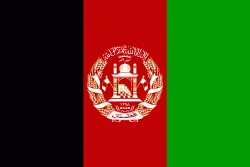 |
 |
| Flag of Afghanistan | |
Human habitation in Afghanistan dates back to the Middle Paleolithic era, and the country's strategic location along the historic Silk Road has led it to being described, picturesquely, as the ‘roundabout of the ancient world’. Popularly referred to as the graveyard of empires, the land has historically been home to various peoples and has witnessed numerous military campaigns, including those by the Persians, Alexander the Great, the Maurya Empire, Arab Muslims, the Mongols, the British, the Soviet Union, and most recently by a US-led coalition. Afghanistan also served as the source from which the Greco-Bactrians and the Mughals, amongst others, rose to form major empires. The various conquests and periods in both the Iranian and Indian cultural spheres made the area a center for Zoroastrianism, Buddhism, Hinduism, and later Islam throughout history.
Currency / Language
| ISO | Currency | Symbol | Significant figures |
|---|---|---|---|
| AFN | Afghan afghani | Ø‹ | 2 |
| ISO | Language |
|---|---|
| PS | Pashto language |
| FA | Persian language |
| TK | Turkmen language |
| UZ | Uzbek language |






